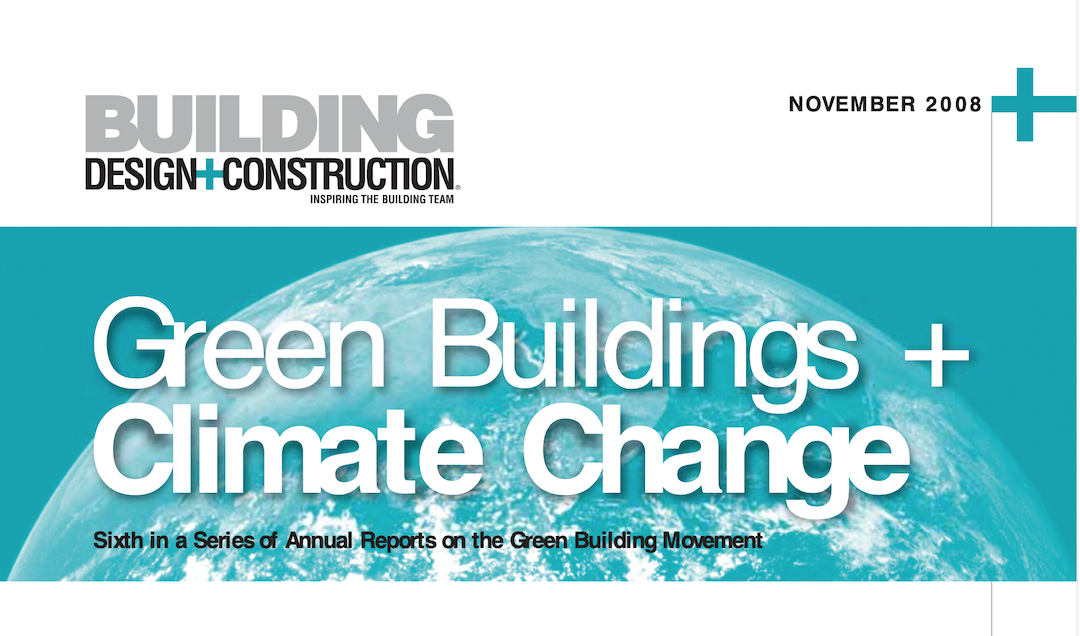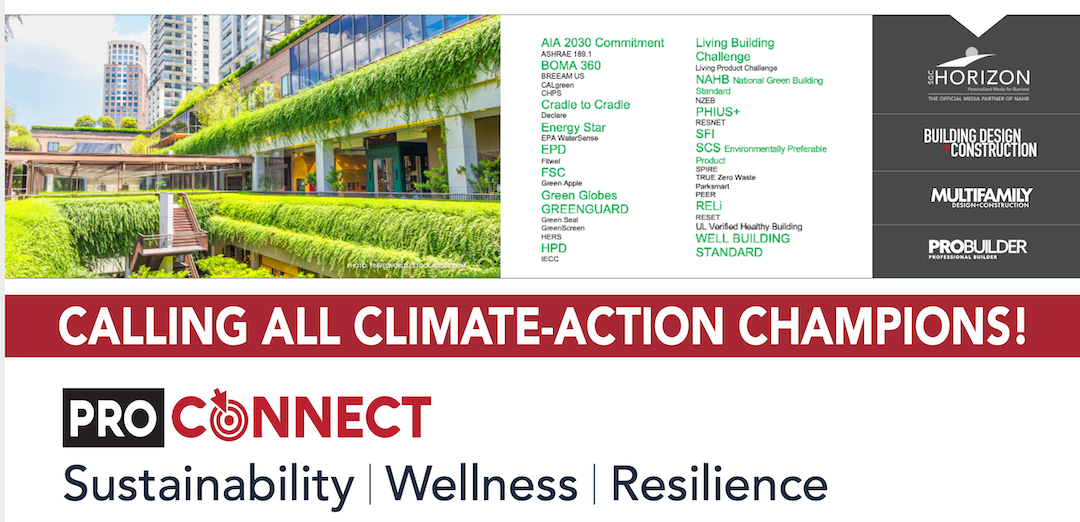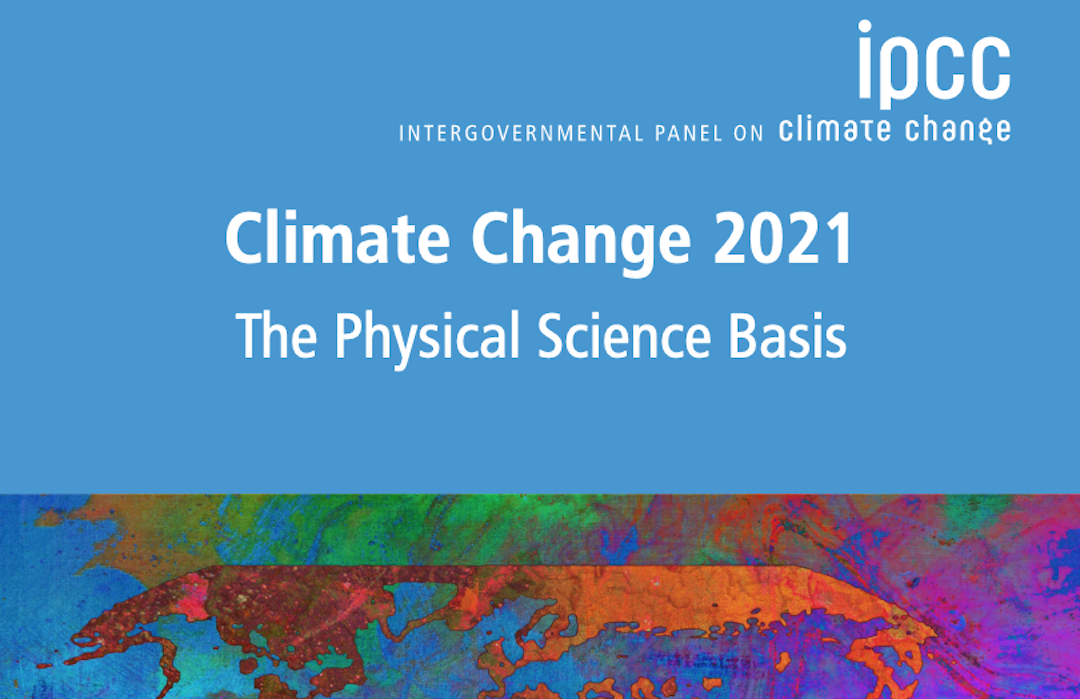The recent report of the UN Intergovernmental Panel on Climate Change, Climate Change 2021: The Physical Science Basis, is not a happy read.
The IPCC report provides new estimates of the chances of crossing the crucial global warming level of 1.5°C in the coming decades. It finds that “unless there are immediate, rapid, and large-scale reductions in greenhouse gas emissions, limiting warming to close to 1.5°C or even 2°C will be beyond reach.” A 1.5°C increase in global warming is believed to be the point at which climate change would be irreversible. To quote the report’s chief author, Joeri Roejl, PhD, “The greater weight of evidence has confirmed the trend, as expected, and it’s not really good news.”
As you’ve heard many times, existing and new-construction buildings and homes are the biggest source of global carbon emissions: 39%—28% for operations (heating and cooling, lighting, etc.), 11% for building materials and construction. (“Industry” contributes 32%; “transportation,” 23%.) Clearly, the building sector plays the leading role in this global drama.
SUSTAINABILITY AND CLIMATE CHANGE, CIRCA 2003
At Building Design+Construction, we’ve been writing about ways AEC professionals and building product manufacturers have improved energy and water efficiency in buildings since well before the scientific community had firmly established humankind’s role in climate change.
In 2003, as the U.S. Green Building Council and its powerful new green building certification system, LEED, were ramping up, we published our “White Paper on Sustainability,” the first in-depth investigation of the fast-emerging green building movement, and followed it up in 2004 with a “Progress Report on Sustainability.”
Each of these reports offered specific recommendations for action, such as “launch a pilot program in 10 large public school districts to measure the impact of green schools on student achievement and health,” and named the parties who should be responsible for carrying out these measures (in this case, six schools organizations and government entities) and "promote a national program to reduce construction and demolition waste by 50% in five years" (progressive GC firms would be hitting 90-95% C+D waste reduction in very short order).

BD+C PUBLISHES ‘GREEN BUILDINGS + CLIMATE CHANGE’ WHITE PAPER
In 2008, we published our most ambitious white paper, a 40,000-word, 64-page report, “Green Buildings + Climate Change,” which spelled out 22 practical steps that design and construction firms could take to flatten the GHG growth curve.
Some of our recommendations were fairly easy for the AEC community to undertake; for example, AEC firms should “fit out your own office to reduce GHG emissions”—a practical step many AEC firms have taken in the interim, often at the LEED Platinum level.
Other recommendations had more bite and required considerably greater investment of time, money, and thinking by larger and more extensive constituencies:
- “Give much greater attention to special threats to waterfront developments and buildings in severe-weather zones”—as evidenced by 2012’s Superstorm Sandy and, recently, more frequent and powerful superstorms and hurricanes.
- “Cities and counties should plug the leaks in the 72,000 miles of water pipes and sewer mains” that were 80 years old or more at that time (sounds like an early call for an infrastructure program, doesn’t it?)
ENCOURAGING THE USE OF SUSTAINABLE PRODUCTS
Two recommendations from the 2008 report merit further consideration today.
The first advised AEC firms to “work with your clients to encourage them to use the most energy-efficient products and systems in their [building] projects.”
Since the early days of LEED, we have seen the proliferation of certification programs for building products—Greenguard, Greenseal, Cradle to Cradle, FSC and SFI (for wood), Red List Free, etc. There are now more than 50 certification programs for building products, buildings, homes, whole neighborhoods, sites, parking structures, schools, and more.
The second recommendation from 2008 encouraged AEC firms to “leverage your supply chain to achieve GHG reductions.” We noted that Turner Construction, the largest building contractor in the U.S. (currently, $14 billion/year in construction), purchases many building products and equipment in high volume to achieve dollar savings for its clients.
We recommended that “giant GCs” like Turner—as well as states, counties, and cities—take this tool one step further and use their purchasing power to “encourage (or require) suppliers to post the carbon emissions of their products and systems online or in their purchase orders.” Many suppliers are doing that in one form or other, via environmental or health product declarations) or via so-called ESG (environmental, social, and governance) impact reports.
Recommendations like these from 13 years ago may seem modest in the context of the current climate crisis, but they were fairly radical at the time and often drew criticism from some in the AEC world who denied that human activity had any role in climate change.
AECO FIRMS TAKING ACTION ON CLIMATE CHANGE
Today, there is a burning desire among progressive architecture, engineering, and construction firms, as well as among forward-thinking real estate development companies, to address climate change.
Eight hundred architecture irms have signed on to the AIA 2030 Commitment to achieve carbon neutrality in their building projects by 2030. The Carbon Leadership Forum is shedding light on the embodied carbon content of building materials and products. The ILFI’s Living Building Challenge 4.0 is pushing AEC firms higher and higher in terms of sustainable design, especially regarding materials.
Just 10 years ago, net-zero buildings were thought to be impossible to achieve. (See “Zero + Net-Zero Energy Buildings + Homes,” March 2011.) Today, net-positive buildings — those that make more energy than they use — are being built.
LATEST CONCERN: CUTTING JOB-SITE CARBON EMISSIONS
This past July, AGC of America formed a Climate Change Task Force to hone in on “the top impacts associated with climate change for construction markets and construction firms.”
Among the task force members are The Beck Group, Clark Construction Group, Linbeck Group, McCarthy Holdings, and Swinerton.
One of the “discussion points” that the AGC Task Force plans to undertake is to “engage with equipment manufacturers to improve energy efficiency and emissions performance without sacrificing safety or power output.”
“Construction activity” accounts for less than 2% of global GHG emissions, but that’s not stopping the nation’s major contractors from pushing construction equipment manufacturers and suppliers to slash carbon emissions on the job site. One sustainability director told me that their firm was committed to cutting on-site GHG emissions by 50% by the end of this decade.
In Northern California, a coalition of GCs called the Bay Area Sustainable Construction Leaders is asking equipment manufacturers and rental companies what they’re doing to electrify their fleets. All the major equipment makers, from Caterpillar to Volvo, know they have to electrify as quickly as possible. Ford has introduced the all-electric F-150 Lightning work truck. Sunbelt Rentals has issued a “Sustainability Plan 2030” that aligns with eight of the 17 UN Sustainable Development Goals. It’s a movement that would have been unheard of 10 years ago,
‘SUSTAINABILITY’ NOW ALSO MEANS ‘WELLNESS’ AND ‘RESILIENCE’
These days, “sustainability” is much more than energy savings (although saving energy remains crucial to reducing carbon emissions). Protecting the health and wellness of building occupants, visitors, and staff has become a huge component of sustainability, especially in light of the Covid pandemic. Programs like WELL Certified and Fitwel Ambassadors are addressing AECO professionals’ concerns about healthy buildings, just as the RELi standard is taking on building resilience. The climate change landscape is getting wider and deeper than ever.

NEW ‘PROCONNECT’ PROGRAM ADDRESSES SUSTAINABILITY
This year, in response to the rapidly developing global warming landscape, Building Design+Construction and our parent company, SGC Horizon, have introduced ProCONNECT Sustainability | Wellness | Resilience (Nov 2-3, 2021, 11am to 4:25pm ET).
ProCONNECT Sustainability gives AEC Professionals and Developers with responsibility for high-performance buildings — Chief Sustainability Officers, Directors of Sustainability, LEED Fellows, LFAs, WELL APs, resilience directors, net-zero building experts, and other “climate-action champions” — the opportunity to meet one-on-one with top product manufacturers to discuss their firms’ climate-action, wellness, and resilience agendas and discover practical solutions that can enhance their firms’ high-performance projects.
More than 40 AEC firms, developers, and consultants have committed to participating in ProCONNECT Sustainability. There is no charge for Attendees. To learn more, click here.
Building product manufacturers and suppliers who would like more information about sponsoring ProCONNECT Sustainability can contact: Dan Gardner, dgardner@sgcmail.com, 989.860.7930, or click here.
Related Stories
| Feb 15, 2011
New 2030 Challenge to include carbon footprint of building materials and products
Architecture 2030 has just broadened the scope of its 2030 Challenge, issuing an additional challenge regarding the climate impact of building products. The 2030 Challenge for Products aims to reduce the embodied carbon (meaning the carbon emissions equivalent) of building products 50% by 2030.
| Feb 15, 2011
New Urbanist Andrés Duany: We need a LEED Brown rating
Andrés Duany advocates a "LEED Brown" rating that would give contractors credit for using traditional but low cost measures that are not easy to quantify or certify. He described these steps as "the original green," and "what we did when we didn't have money." Ostensibly, LEED Brown would be in addition to the current Silver, Gold and Platinum ratings.
| Feb 14, 2011
Sustainable Roofing: A Whole-Building Approach
According to sustainability experts, the first step toward designing an energy-efficient roofing system is to see roof materials and systems as an integral component of the enclosure and the building as a whole. Earn 1.0 AIA/CES learning units by studying this article and successfully completing the online exam.
| Feb 14, 2011
More companies willing to pay extra for green office space
New CoreNet Global/Jones Lang LaSalle survey shows real estate executives forging green strategies that balance environmental, financial and workforce issues.
| Feb 11, 2011
Sustainable features on the bill for dual-building performing arts center at Soka University of America
The $73 million Soka University of America’s new performing arts center and academic complex recently opened on the school’s Aliso Viejo, Calif., campus. McCarthy Building Companies and Zimmer Gunsul Frasca Architects collaborated on the two-building project. One is a three-story, 47,836-sf facility with a grand reception lobby, a 1,200-seat auditorium, and supports spaces. The other is a four-story, 48,974-sf facility with 11 classrooms, 29 faculty offices, a 150-seat black box theater, rehearsal/dance studio, and support spaces. The project, which has a green roof, solar panels, operable windows, and sun-shading devices, is going for LEED Silver.
| Feb 11, 2011
Kentucky’s first green adaptive reuse project earns Platinum
(FER) studio, Inglewood, Calif., converted a 115-year-old former dry goods store in Louisville, Ky., into a 10,175-sf mixed-use commercial building earned LEED Platinum and holds the distinction of being the state’s first adaptive reuse project to earn any LEED rating. The facility, located in the East Market District, houses a gallery, event space, offices, conference space, and a restaurant. Sustainable elements that helped the building reach its top LEED rating include xeriscaping, a green roof, rainwater collection and reuse, 12 geothermal wells, 81 solar panels, a 1,100-gallon ice storage system (off-grid energy efficiency is 68%) and the reuse and recycling of construction materials. Local firm Peters Construction served as GC.
| Feb 11, 2011
Justice center on Fall River harbor serves up daylight, sustainable elements, including eucalyptus millwork
Located on historic South Main Street in Fall River, Mass., the Fall River Justice Center opened last fall to serve as the city’s Superior and District Courts building. The $85 million facility was designed by Boston-based Finegold Alexander + Associates Inc., with Dimeo Construction as CM and Arup as MEP. The 154,000-sf courthouse contains nine courtrooms, a law library, and a detention area. Most of the floors have the same ceiling height, which will makes them easier to reconfigure in the future as space needs change. Designed to achieve LEED Silver, the facility’s elliptical design offers abundant natural daylight and views of the harbor. Renewable eucalyptus millwork is one of the sustainable features.
| Feb 10, 2011
Zero Energy Buildings: When Do They Pay Off in a Hot and Humid Climate?
There’s lots of talk about zero energy as the next big milestone in green building. Realistically, how close are we to this ambitious goal? At this point, the strategies required to get to zero energy are relatively expensive. Only a few buildings, most of them 6,000 sf or less, mostly located in California and similar moderate climates, have hit the mark. What about larger buildings, commercial buildings, more problematic climates? Given the constraints of current technology and the comfort demands of building users, is zero energy a worthwhile investment for buildings in, for example, a warm, humid climate?
| Feb 9, 2011
Fortune 1000: Despite moral obligation to sustainability, cash is still king
Eighty-eight percent of Fortune 1000 senior executives feel business has a moral responsibility, beyond regulatory requirements, to make their companies more energy efficient, according to a new poll released today by Harris Interactive and commissioned by Schneider Electric. At the same time, the vast majority (61%) of respondents say that potential cost savings are their biggest motivator to save energy at the enterprise-level, outranking environmental concerns (13%) or government regulations (2%).












